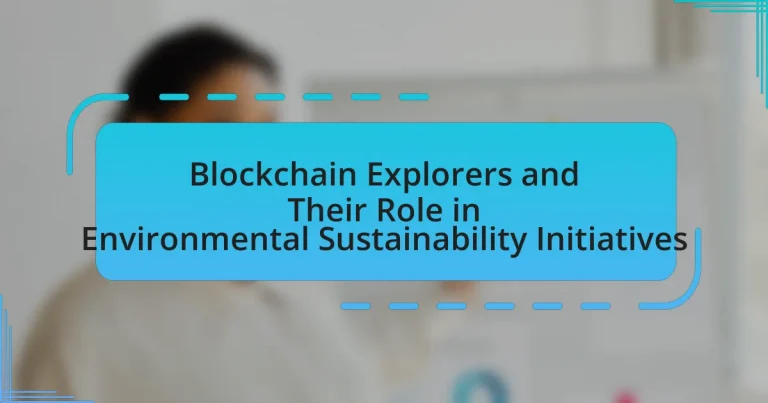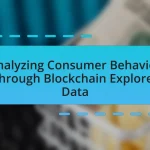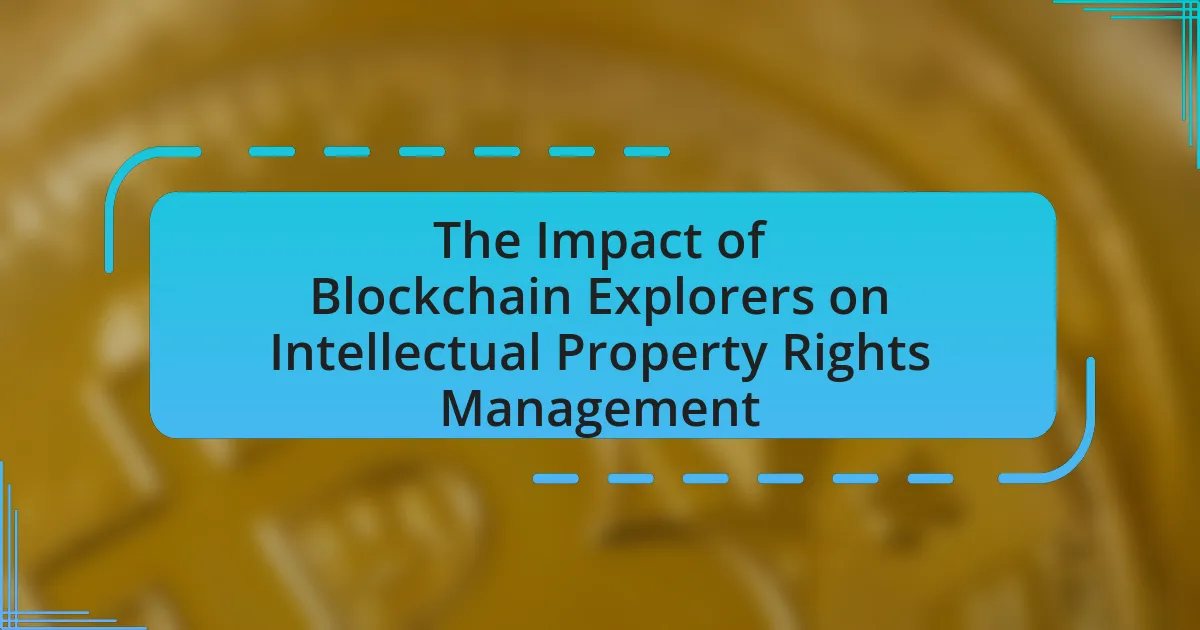Blockchain explorers are essential tools that provide users with the ability to view and analyze blockchain data, significantly contributing to environmental sustainability initiatives. They enhance transparency and traceability in supply chains, allowing for the responsible sourcing of materials and the verification of carbon credits. By tracking various sustainability metrics, blockchain explorers facilitate accountability among organizations, promote eco-friendly practices, and support renewable energy projects. This article explores the functionality of blockchain explorers, their impact on environmental initiatives, and the challenges organizations face in integrating this technology into their sustainability efforts.
What are Blockchain Explorers and Their Importance in Environmental Sustainability Initiatives?
Blockchain explorers are tools that allow users to view and analyze blockchain data, including transaction histories, block details, and network statistics. Their importance in environmental sustainability initiatives lies in their ability to enhance transparency and traceability in supply chains, particularly for sustainable practices. For instance, blockchain explorers can track the origin of materials, ensuring that they are sourced responsibly, which is crucial for initiatives aimed at reducing environmental impact. Additionally, they facilitate the verification of carbon credits and other sustainability metrics, enabling organizations to demonstrate compliance with environmental standards. This transparency fosters trust among stakeholders and encourages more sustainable practices within industries.
How do Blockchain Explorers function in tracking environmental data?
Blockchain explorers function by providing a transparent and immutable record of environmental data transactions on a blockchain. They allow users to view and verify data related to environmental initiatives, such as carbon credits, renewable energy certificates, and pollution metrics, in real-time. This transparency ensures that stakeholders can trust the accuracy of the data, as each entry is time-stamped and linked to previous records, making it difficult to alter or falsify information. For instance, projects like Energy Web Foundation utilize blockchain explorers to track renewable energy generation, ensuring that the data is accessible and verifiable by all parties involved.
What types of data can Blockchain Explorers track related to sustainability?
Blockchain Explorers can track various types of data related to sustainability, including carbon credits, energy consumption, supply chain transparency, and waste management metrics. For instance, they can monitor transactions that represent carbon offset initiatives, allowing users to verify the authenticity and impact of these credits. Additionally, Blockchain Explorers can provide insights into the energy usage of blockchain networks themselves, which is crucial for assessing their environmental footprint. They also facilitate the tracking of sustainable sourcing in supply chains by providing immutable records of product origins and certifications. Lastly, data on waste management practices can be recorded and analyzed, helping organizations to improve recycling efforts and reduce landfill contributions.
How does the transparency of Blockchain Explorers enhance environmental initiatives?
The transparency of Blockchain Explorers enhances environmental initiatives by providing verifiable data on transactions and resource usage. This transparency allows stakeholders to track the carbon footprint and sustainability practices of organizations, ensuring accountability and promoting eco-friendly behaviors. For instance, projects like Energy Web Chain utilize blockchain technology to monitor renewable energy generation and consumption, enabling users to verify the source of their energy and its environmental impact. Such data-driven insights empower consumers and businesses to make informed decisions that align with sustainability goals, ultimately fostering a culture of environmental responsibility.
Why are Blockchain Explorers considered vital for environmental sustainability?
Blockchain explorers are considered vital for environmental sustainability because they provide transparency and traceability in tracking carbon credits and sustainable practices. By enabling users to verify transactions and the origins of carbon offsets, blockchain explorers facilitate accountability in environmental initiatives. For instance, projects like the Energy Web Foundation utilize blockchain technology to ensure that renewable energy certificates are accurately recorded and monitored, thus promoting trust in sustainability claims. This transparency helps prevent fraud and encourages more organizations to engage in environmentally friendly practices, ultimately supporting global sustainability efforts.
What role do Blockchain Explorers play in promoting accountability in sustainability efforts?
Blockchain explorers play a crucial role in promoting accountability in sustainability efforts by providing transparent access to transaction data on blockchain networks. This transparency allows stakeholders, including consumers and organizations, to verify the authenticity of sustainability claims, track the flow of resources, and ensure that funds are being used for their intended environmental purposes. For instance, projects like Provenance utilize blockchain explorers to trace the supply chain of products, enabling consumers to see the environmental impact of their purchases. This level of visibility fosters trust and encourages responsible practices among businesses, as they are held accountable for their sustainability commitments.
How do Blockchain Explorers facilitate collaboration among stakeholders in environmental projects?
Blockchain explorers facilitate collaboration among stakeholders in environmental projects by providing transparent access to data related to project activities, transactions, and outcomes. This transparency allows stakeholders, such as project managers, investors, and community members, to verify information and track progress in real-time, fostering trust and accountability. For instance, blockchain explorers can display the carbon credits generated by a reforestation project, enabling stakeholders to see the impact of their contributions. This verifiable data encourages informed decision-making and enhances stakeholder engagement, ultimately leading to more effective collaboration in achieving environmental sustainability goals.
What specific environmental sustainability initiatives benefit from Blockchain Explorers?
Blockchain Explorers benefit specific environmental sustainability initiatives such as carbon credit tracking, supply chain transparency, and renewable energy certification. These initiatives leverage blockchain technology to create immutable records that enhance accountability and traceability. For instance, carbon credit tracking systems utilize blockchain to verify and trade carbon credits, ensuring that emissions reductions are accurately reported and incentivized. Supply chain transparency initiatives use blockchain to trace the origin of materials, promoting ethical sourcing and reducing environmental impact. Additionally, renewable energy certification programs rely on blockchain to verify the production and consumption of green energy, facilitating the growth of sustainable energy markets.
How do Blockchain Explorers support renewable energy projects?
Blockchain explorers support renewable energy projects by providing transparency and traceability in energy transactions. They enable users to track the generation and consumption of renewable energy, ensuring that energy credits are accurately recorded and verified. This transparency helps to build trust among stakeholders, including consumers, producers, and regulators. For instance, projects utilizing blockchain technology can demonstrate the origin of renewable energy, which is crucial for compliance with sustainability standards and for attracting investments. By facilitating peer-to-peer energy trading, blockchain explorers also empower individuals and communities to participate in renewable energy markets, enhancing the overall efficiency and adoption of sustainable energy solutions.
What examples exist of Blockchain Explorers being used in renewable energy tracking?
Blockchain explorers are utilized in renewable energy tracking through platforms like Power Ledger and WePower. Power Ledger employs blockchain technology to enable peer-to-peer energy trading, allowing users to track energy generation and consumption transparently. WePower facilitates the purchase of renewable energy directly from producers, using blockchain to ensure the authenticity of energy credits and track transactions. These examples demonstrate how blockchain explorers enhance transparency and efficiency in renewable energy markets, supporting sustainability initiatives.
How do these explorers improve the efficiency of renewable energy distribution?
Blockchain explorers improve the efficiency of renewable energy distribution by providing transparent and real-time tracking of energy transactions. This transparency allows for better coordination among producers, consumers, and grid operators, reducing energy loss and optimizing resource allocation. For instance, blockchain technology can facilitate peer-to-peer energy trading, enabling users to buy and sell excess energy directly, which enhances market efficiency and encourages the use of renewable sources. Studies have shown that implementing blockchain in energy systems can lead to a reduction in operational costs by up to 30%, demonstrating its effectiveness in improving distribution efficiency.
What impact do Blockchain Explorers have on carbon credit trading?
Blockchain explorers enhance transparency and traceability in carbon credit trading. By providing real-time access to transaction data, they allow stakeholders to verify the authenticity of carbon credits and track their lifecycle from issuance to retirement. This increased transparency helps to reduce fraud and double counting, which are significant issues in carbon markets. For instance, a study by the World Bank indicated that improved data accessibility through blockchain technology could increase market confidence and participation, ultimately leading to more effective carbon trading systems.
How do Blockchain Explorers ensure the integrity of carbon credits?
Blockchain explorers ensure the integrity of carbon credits by providing transparent and immutable records of transactions related to carbon credit issuance, transfer, and retirement. Each carbon credit is represented as a unique digital token on the blockchain, which allows for real-time tracking and verification of its lifecycle. This transparency reduces the risk of fraud and double counting, as all transactions are publicly accessible and verifiable by any stakeholder. Additionally, the use of smart contracts automates compliance with regulatory standards, ensuring that carbon credits are only issued for verified emissions reductions. This system has been validated by various projects, such as the Verra registry, which utilizes blockchain technology to enhance the credibility of carbon credits in the market.
What are the benefits of using Blockchain Explorers in carbon offset projects?
Using Blockchain Explorers in carbon offset projects enhances transparency and traceability of carbon credits. These tools allow stakeholders to verify transactions and track the lifecycle of carbon credits, ensuring that the offsets are legitimate and correspond to actual environmental benefits. For instance, a study by the World Economic Forum highlights that blockchain technology can reduce fraud and increase trust among participants in carbon markets by providing immutable records of carbon credit issuance and retirement. This increased accountability can lead to greater investment in carbon offset initiatives, ultimately supporting environmental sustainability goals.
How can organizations effectively utilize Blockchain Explorers for sustainability?
Organizations can effectively utilize Blockchain Explorers for sustainability by tracking and verifying the provenance of sustainable materials and products. By using Blockchain Explorers, organizations can access transparent and immutable records of transactions, which allows them to confirm that materials are sourced responsibly and ethically. For instance, companies in the supply chain can demonstrate compliance with environmental standards by providing verifiable data on the origin of raw materials, thus enhancing consumer trust and promoting sustainable practices. This approach not only supports sustainability goals but also aligns with increasing regulatory demands for transparency in supply chains.
What best practices should organizations follow when implementing Blockchain Explorers?
Organizations should follow best practices such as ensuring data accuracy, prioritizing user-friendly interfaces, and maintaining robust security protocols when implementing Blockchain Explorers. Ensuring data accuracy involves validating the information displayed on the explorer to prevent misinformation, which is crucial for transparency and trust. Prioritizing user-friendly interfaces enhances accessibility for users, allowing them to navigate and utilize the explorer effectively, which is essential for widespread adoption. Maintaining robust security protocols protects sensitive data and prevents unauthorized access, which is vital given the increasing concerns around data breaches in blockchain technology. These practices collectively contribute to the successful implementation of Blockchain Explorers, fostering trust and engagement in environmental sustainability initiatives.
How can organizations ensure data accuracy and reliability in their Blockchain systems?
Organizations can ensure data accuracy and reliability in their Blockchain systems by implementing robust validation mechanisms and consensus protocols. These mechanisms, such as proof of work or proof of stake, require multiple nodes to verify transactions before they are added to the blockchain, thereby reducing the likelihood of errors or fraudulent entries. Additionally, regular audits and the use of cryptographic techniques enhance data integrity by ensuring that any alterations to the data can be detected. For instance, a study by the World Economic Forum highlights that blockchain’s inherent transparency and immutability can significantly improve data trustworthiness in supply chains, which is crucial for environmental sustainability initiatives.
What strategies can enhance stakeholder engagement through Blockchain Explorers?
Utilizing Blockchain Explorers can enhance stakeholder engagement by providing transparent access to real-time data on environmental initiatives. This transparency fosters trust among stakeholders, as they can independently verify the progress and impact of sustainability projects. For instance, a study by the World Economic Forum highlights that transparency in blockchain applications can increase stakeholder participation by up to 50%, as stakeholders feel more informed and involved in decision-making processes. Additionally, interactive features such as dashboards and visualizations within Blockchain Explorers can facilitate better communication and collaboration among stakeholders, further driving engagement.
What challenges do organizations face when integrating Blockchain Explorers into sustainability initiatives?
Organizations face several challenges when integrating Blockchain Explorers into sustainability initiatives, primarily related to technical complexity, data accuracy, and stakeholder engagement. The technical complexity arises from the need for specialized knowledge to implement and maintain blockchain systems, which can deter organizations lacking in-house expertise. Data accuracy is another significant challenge, as the effectiveness of blockchain in sustainability relies on the integrity of the data inputted; inaccurate or fraudulent data can undermine the entire initiative. Additionally, engaging stakeholders, including suppliers and consumers, is crucial, yet organizations often struggle to align diverse interests and ensure widespread adoption of blockchain technology. These challenges highlight the multifaceted nature of integrating Blockchain Explorers into sustainability efforts, necessitating a strategic approach to overcome them.
How can organizations overcome technical barriers in adopting Blockchain technology?
Organizations can overcome technical barriers in adopting Blockchain technology by investing in training and education for their workforce. This approach ensures that employees possess the necessary skills to understand and implement Blockchain solutions effectively. A study by the World Economic Forum highlights that 77% of executives believe a lack of skilled talent is a significant barrier to Blockchain adoption. By providing targeted training programs and collaborating with educational institutions, organizations can build a knowledgeable workforce capable of navigating the complexities of Blockchain technology.
What are the regulatory considerations for using Blockchain Explorers in environmental projects?
Regulatory considerations for using Blockchain Explorers in environmental projects include compliance with data privacy laws, adherence to environmental regulations, and ensuring transparency in reporting. Data privacy laws, such as the General Data Protection Regulation (GDPR) in Europe, mandate that personal data must be handled with care, which affects how data is recorded and shared on blockchain platforms. Environmental regulations require that projects align with local and international standards for sustainability, ensuring that blockchain applications do not inadvertently violate these laws. Furthermore, transparency is crucial; stakeholders must be able to verify the authenticity of environmental claims made through blockchain, necessitating clear guidelines on data accessibility and auditability. These considerations are essential to maintain legal compliance and foster trust among stakeholders in environmental initiatives.
What are the future trends for Blockchain Explorers in environmental sustainability?
Future trends for Blockchain Explorers in environmental sustainability include enhanced transparency in supply chains, improved carbon tracking, and the integration of decentralized finance (DeFi) for funding green projects. These trends are driven by the increasing demand for accountability in environmental practices, as blockchain technology allows for immutable records that can verify sustainable sourcing and emissions reductions. For instance, companies like Everledger utilize blockchain to track the provenance of diamonds, ensuring ethical sourcing, which can be applied to various industries to promote sustainability. Additionally, platforms like Power Ledger enable peer-to-peer energy trading, facilitating the use of renewable energy sources. These developments indicate a growing reliance on blockchain to support environmental initiatives effectively.
How might advancements in technology influence the role of Blockchain Explorers?
Advancements in technology will enhance the role of Blockchain Explorers by improving their data analysis capabilities and user interfaces. As technologies such as artificial intelligence and machine learning evolve, Blockchain Explorers can leverage these tools to provide deeper insights into blockchain transactions, making it easier for users to track and analyze data related to environmental sustainability initiatives. For instance, enhanced algorithms can identify patterns in transaction data that correlate with sustainability efforts, thereby facilitating more informed decision-making. Additionally, advancements in user interface design will make these explorers more accessible to a broader audience, allowing stakeholders in environmental initiatives to engage with blockchain data more effectively.
What potential innovations could emerge from the intersection of Blockchain and sustainability?
Potential innovations from the intersection of Blockchain and sustainability include enhanced supply chain transparency, carbon credit trading platforms, and decentralized renewable energy systems. Enhanced supply chain transparency allows consumers to verify the sustainability of products through immutable records of sourcing and production processes, thereby promoting ethical consumption. Carbon credit trading platforms leverage blockchain to create secure, transparent markets for trading carbon credits, facilitating compliance with environmental regulations and incentivizing emissions reductions. Decentralized renewable energy systems utilize blockchain to enable peer-to-peer energy trading, allowing individuals to buy and sell excess energy generated from renewable sources, thus optimizing energy distribution and reducing reliance on fossil fuels. These innovations collectively contribute to more sustainable practices and accountability in various sectors.




